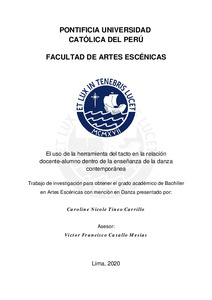| dc.contributor.advisor | Casallo Mesías, Víctor Francisco | |
| dc.contributor.author | Tineo Carrillo, Caroline Nicole | |
| dc.date.accessioned | 2022-05-09T13:35:35Z | |
| dc.date.available | 2022-05-09T13:35:35Z | |
| dc.date.created | 2020 | |
| dc.date.issued | 2022-05-09 | |
| dc.identifier.uri | http://hdl.handle.net/20.500.12404/22277 | |
| dc.description.abstract | Buscar una metodología efectiva y variable es una de las tareas más difíciles en las
que se encuentran los docentes, pues la necesidad de satisfacer los estándares educativos lo
requiere. Los docentes en danza contemporánea se encuentran en la misma situación, por lo
que se han visto en la necesidad de emplear distintas estrategias y herramientas de enseñanza
para lograr que los alumnos puedan comprender y concientizar el movimiento de las
diferentes técnicas presentadas. El tacto es una de esas herramientas, pues gracias a esta se
genera un medio de enseñanza y conexión entre los individuos que practican dicha disciplina
y los educadores, por ende, debe usarse con el cuidado y el valor que este requiere. Cuando
esta no es usada con el respesto que amerita, provoca que se creen diferentes interpretaciones
e incluso situaciones que vulneran a los alumnos.
El presente trabajo, esclarece la responsabilidad ética que tienen los docentes al usar
el tacto como una herramienta de enseñanza dentro de la danza contemporánea, con el
objetivo de cuidar la integridad física y mental de los estudiantes de dicha carrera. A su vez,
se concluye que a pesar de estar en un contexto académico, en donde el docente representa a
una entidad de poder, su responsabilidad ética gira en torno a asegurarle al estudiante que se
encuentra en la total libertad de decidir cuando este acciona en su cuerpo y por ende, de
cuidar de su integridad como alumno. | es_ES |
| dc.description.abstract | Searching an effective and variable methodology is one of the most difficult tasks in
which teachers find themselves, since the need to meet educational standards requires it.
Contemporary dance teachers are in the same situation, which is why they have seen the need
to use different teaching strategies and tools to achieve that students can understand and raise
aware of the movement of the different techniques. Touch is one of those tools, because
thanks to it a means of teaching and connection is generated between the individuals who
practice this discipline and the educators, thus, it must be used with the care and value that it
requires. When this is not used with the respect it deserves, it causes different interpretations
and even situations that infringe the students to be created.
The present work clarifies the ethical responsibility that teachers have when using
touch as a teaching tool within contemporary dance, with the objective of taking care of the
physical and mental integrity of the students of said career. In turn, it is concluded that despite
being in an academic context, where the teacher represents an entity of power, his ethical
responsibility revolves around assuring the student that he is in total freedom to decide when
he acts in his body and therefore, to take care of his integrity as a student. | es_ES |
| dc.language.iso | spa | es_ES |
| dc.publisher | Pontificia Universidad Católica del Perú | es_ES |
| dc.rights | Atribución 2.5 Perú | * |
| dc.rights | info:eu-repo/semantics/openAccess | es_ES |
| dc.rights.uri | http://creativecommons.org/licenses/by/2.5/pe/ | * |
| dc.subject | Danza--Estudio y enseñanza (Superior) | es_ES |
| dc.subject | Danza moderna--Técnica | es_ES |
| dc.subject | Tacto | es_ES |
| dc.title | El uso de la herramienta del tacto en la relación docente-alumno dentro de la enseñanza de la danza contemporánea | es_ES |
| dc.type | info:eu-repo/semantics/bachelorThesis | es_ES |
| thesis.degree.name | Bachiller en Artes Escénicas con mención en Danza | es_ES |
| thesis.degree.level | Bachillerato | es_ES |
| thesis.degree.grantor | Pontificia Universidad Católica del Perú. Facultad de Artes Escénicas | es_ES |
| thesis.degree.discipline | Artes Escénicas con mención en Danza | es_ES |
| renati.advisor.dni | 07618700 | |
| renati.advisor.orcid | https://orcid.org/0000-0001-7954-5780 | es_ES |
| renati.author.dni | 72880769 | |
| renati.discipline | 215106 | es_ES |
| renati.level | https://purl.org/pe-repo/renati/level#bachiller | es_ES |
| renati.type | https://purl.org/pe-repo/renati/type#trabajoDeInvestigacion | es_ES |
| dc.publisher.country | PE | es_ES |
| dc.subject.ocde | https://purl.org/pe-repo/ocde/ford#6.04.04 | es_ES |






